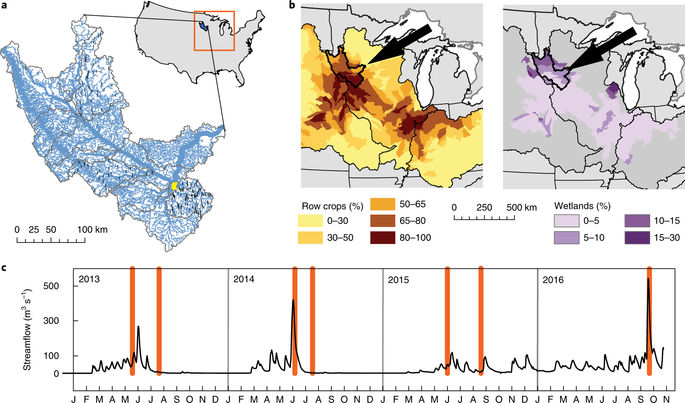Nature Geoscience ( IF 15.7 ) Pub Date : 2018-01-29 , DOI: 10.1038/s41561-017-0056-6 Amy T. Hansen , Christine L. Dolph , Efi Foufoula-Georgiou , Jacques C. Finlay

|
Intensively managed row crop agriculture has fundamentally changed Earth surface processes within the Mississippi River basin through large-scale alterations of land cover, hydrology and reactive nitrogen availability. These changes have created leaky landscapes where excess agriculturally derived nitrate degrades riverine water quality at local, regional and continental scales. Individually, wetlands are known to remove nitrate but the conditions under which multiple wetlands meaningfully reduce riverine nitrate concentration have not been established. Only one region of the Mississippi River basin—the 44,000 km2 Minnesota River basin—still contains enough wetland cover within its intensively agriculturally managed watersheds to empirically address this question. Here we combine high-resolution land cover data for the Minnesota River basin with spatially extensive repeat water sampling data. By clearly isolating the effect of wetlands from crop cover, we show that, under moderate–high streamflow, wetlands are five times more efficient per unit area at reducing riverine nitrate concentration than the most effective land-based nitrogen mitigation strategies, which include cover crops and land retirement. Our results suggest that wetland restorations that account for the effects of spatial position in stream networks could provide a much greater benefit to water quality then previously assumed.
中文翻译:

流域尺度上湿地对硝酸盐去除的贡献
集约经营的行间作物农业通过大规模改变土地覆盖,水文学和活性氮的利用,从根本上改变了密西西比河流域内的地球表面过程。这些变化造成了漏水的景观,其中过量的农业硝酸盐在地方,区域和大陆范围内降低了河流的水质。个别地,已知湿地会去除硝酸盐,但尚未建立多个湿地有效降低河流硝酸盐浓度的条件。密西西比河流域的仅一个地区-44,000 km 2明尼苏达州流域—在集约化农业管理的集水区中仍然包含足够的湿地覆盖,以凭经验解决这个问题。在这里,我们将明尼苏达河流域的高分辨率土地覆盖数据与空间广泛的重复水样采样数据相结合。通过清楚地将湿地的影响与作物覆盖隔离,我们表明,在中等至高流量下,湿地在降低河流硝酸盐浓度方面的效率是最有效的陆基氮缓解策略(包括覆盖作物)的五倍。和土地退役。我们的结果表明,考虑到河流网络中空间位置的影响的湿地恢复可以比以前假定的水质提供更大的收益。











































 京公网安备 11010802027423号
京公网安备 11010802027423号